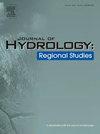Changes of blue and green water in arid inland dissipation area based on coupled surface water and groundwater model
IF 4.7
2区 地球科学
Q1 WATER RESOURCES
引用次数: 0
Abstract
Study region
The Mainstream in the Tarim River Basin, Southern Xinjiang, China
Study focus
Climate change and human activities have significantly altered the water cycle, and water security evaluation and management are urgent. In arid and semi-arid areas, the assessment of blue and green water is particularly important. In this study, the MIKE SHE model is used to simulate the spatial and temporal changes of blue and green water resources in the mainstream of the Tarim River Basin (TRB) from 1990 to 2050 under land use and climate change conditions. The scarcity and vulnerability of blue-green water are introduced to evaluate the water security of the basin. The impacts of different land uses on blue-green water resources were also calculated according to the model zoning.
New hydrological insights for the region
The results indicate that from 1990 to 2050, blue water resources show a spatial pattern of gradual decrease from upstream to downstream. Compared to blue water, green water is dispersed more evenly over space. Future climatic scenarios will impact water security, as will changes in blue and green water security in terms of time and space. By comparing the influence of ecological water transport on the change of blue and green water before and after 2000, it was found that environmental water transport plays a certain role in improving the blue water scarcity in downstream of the TRB. The study is significant in maintaining regional water security and ecosystem stability.
基于地表水和地下水耦合模型的干旱内陆消落区蓝水和绿水的变化
研究地区中国新疆南部塔里木河流域的主流研究重点气候变化和人类活动极大地改变了水循环,水安全评估和管理迫在眉睫。在干旱和半干旱地区,蓝水和绿水的评估尤为重要。本研究利用 MIKE SHE 模型模拟了在土地利用和气候变化条件下,塔里木河流域(TRB)主流地区从 1990 年到 2050 年蓝色和绿色水资源的时空变化。引入蓝绿水的稀缺性和脆弱性来评估流域的水安全。结果表明,从 1990 年到 2050 年,蓝水资源呈现出从上游到下游逐渐减少的空间格局。与蓝水相比,绿水的空间分布更为均匀。未来的气候情景将对水安全产生影响,而蓝水和绿水安全在时间和空间上的变化也将对水安全产生影响。通过比较 2000 年前后生态输水对蓝水和绿水变化的影响,发现环境输水对改善 TRB 下游蓝水稀缺状况有一定作用。该研究对维护区域水安全和生态系统稳定具有重要意义。
本文章由计算机程序翻译,如有差异,请以英文原文为准。
求助全文
约1分钟内获得全文
求助全文
来源期刊

Journal of Hydrology-Regional Studies
Earth and Planetary Sciences-Earth and Planetary Sciences (miscellaneous)
CiteScore
6.70
自引率
8.50%
发文量
284
审稿时长
60 days
期刊介绍:
Journal of Hydrology: Regional Studies publishes original research papers enhancing the science of hydrology and aiming at region-specific problems, past and future conditions, analysis, review and solutions. The journal particularly welcomes research papers that deliver new insights into region-specific hydrological processes and responses to changing conditions, as well as contributions that incorporate interdisciplinarity and translational science.
 求助内容:
求助内容: 应助结果提醒方式:
应助结果提醒方式:


